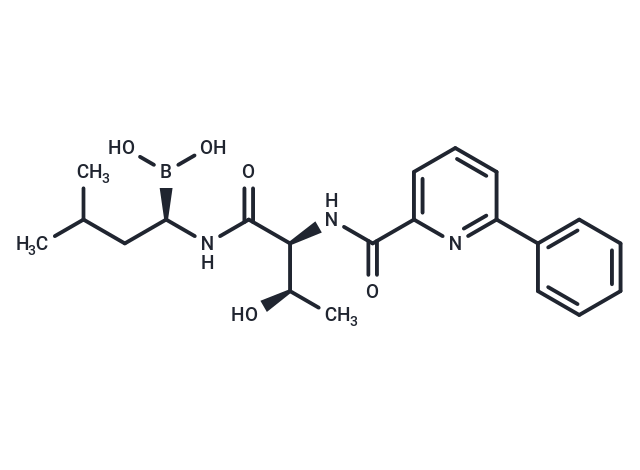购物车
- 全部删除
 您的购物车当前为空
您的购物车当前为空

Delanzomib (CEP-18770) 是一种强效的具有口服活性的蛋白酶体的胰凝乳蛋白酶样活性抑制剂,IC50为 3.8 nM。它抑制NF-κB 活性,诱导癌细胞凋亡,具有很强的抗血管生成和抗癌活性。


为众多的药物研发团队赋能,
让新药发现更简单!
Delanzomib (CEP-18770) 是一种强效的具有口服活性的蛋白酶体的胰凝乳蛋白酶样活性抑制剂,IC50为 3.8 nM。它抑制NF-κB 活性,诱导癌细胞凋亡,具有很强的抗血管生成和抗癌活性。
| 规格 | 价格 | 库存 | 数量 |
|---|---|---|---|
| 2 mg | ¥ 558 | 现货 | |
| 5 mg | ¥ 962 | 现货 | |
| 10 mg | ¥ 1,490 | 现货 | |
| 25 mg | ¥ 2,980 | 现货 | |
| 50 mg | ¥ 4,650 | 现货 | |
| 100 mg | ¥ 6,630 | 现货 | |
| 200 mg | ¥ 8,830 | 现货 | |
| 1 mL x 10 mM (in DMSO) | ¥ 997 | 现货 |
| 产品描述 | Delanzomib (CEP-18770) is an orally active inhibitor of the chymotrypsin-like activity of proteasome (IC50: 3.8 nM). It only marginally inhibits the tryptic and peptidylglutamyl activities of the proteosome. |
| 靶点活性 | Chymotrypsin-like proteasome:3.8 nM |
| 体外活性 | CEP-18770展现了对蛋白酶体的胰蛋白酶样和肽酰谷氨酰活性的有限阻断能力,其IC50值与bortezomib相当,能在低纳摩尔浓度下抑制蛋白酶体的胰蛋白酶样和类凋亡酶活性。[1] CEP-18770对包括A2780卵巢癌细胞、PC3前列腺癌细胞、H460、LoVo结肠癌细胞、RPMI8226多发性骨髓瘤和HS-Sultan非霍奇金淋巴瘤等癌症细胞的IC50值分别为13.7、22.2、34.2、11.3、5.6和8.2 nM。[1] CEP-18770在多发性骨髓瘤(MM)和慢性髓细胞性白血病细胞系K562中阻断泛素-蛋白酶体途径,引发泛素化蛋白质在4到8小时内积累,其特征与bortezomib处理后观察到的相似。[1] 预处理CEP-18770可完全阻断IκBα的降解。在RPMI-8226和U266细胞中,CEP-18770显著抑制高水平的NF-κB活性。CEP-18770对MM细胞系中NF-κB DNA结合活性的时间和浓度依赖性抑制导致了包括IκBα、X染色体连锁凋亡抑制蛋白(XIAP)、促炎细胞因子TNF-α和白细胞介素-1β(IL-1β)、细胞间黏附分子(ICAM1)及促血管生成因子血管内皮生长因子等数个由NF-κB调控、介导肿瘤细胞生长和存活的基因表达的下降。[1] 这些由NF-κB调控的基因表达及其受bortezomib调控的方式,凸显了它们在响应CEP-18770暴露方面的潜在预后价值,从而与此化合物的更佳Clinical反应性相关。 |
| 体内活性 | CEP-18770展示了剂量相关的相对肿瘤重量抑制,并且与硼替佐米比较,以1.2 mg/kg静脉注射的最大耐受剂量(MTD)实现50%完全缓解(CR)的发生率相比,CEP-18770引导剂量相关的完全肿瘤退化。与硼替佐米不同,CEP-18770在完成这些研究(肿瘤移植后120天)时,肿瘤自由小鼠的发生率呈剂量相关增加。CEP-18770的口服给药在120天研究期间显著减少肿瘤重量,并且完全肿瘤退化的剂量相关发生率明显,同时动物体重变化最小。与硼替佐米比较,等效剂量的CEP-18770显示出更大且更持久的剂量相关肿瘤蛋白酶体活性抑制,并且与caspase-3和7活性的最大诱导临时对应。CEP-18770的最大凋亡信号是硼替佐米的2.5倍。相比之下,CEP-18770和硼替佐米在正常的外围小鼠组织(肝、肺、全血和大脑[无活性])检查中的蛋白酶体抑制剖面在其幅度和持续时间上是可比的。在任何时间点,两者的大脑组织中都未检测到蛋白酶体抑制。在MM异种移植模型中,CEP-18770与美法兰的组合能完全阻止对美法兰敏感或美法兰耐药肿瘤的生长。CEP-18770与硼替佐米的组合导致对硼替佐米敏感的肿瘤完全退化,并与单一化合物治疗相比,明显延缓对硼替佐米耐药肿瘤的进展。单一化合物CEP-18770 PO在这些异种移植模型中也显示出显著的抗MM效应。 |
| 激酶实验 | Probing proteasome activity in cell extracts: Human multiple myeloma cells are washed twice with cold phosphate-buffered saline, pelleted and lysed with one volume of glass beads (<106 microns, acid-washed) and an equal volume of homogenization buffer (50 mM Tris (pH 7.4), 1 mM dithiothreitol, 5 mM MgCl2, 2 mM ATP and 250 mM sucrose) by vortexing at high speed for 15-30 min at 4 °C. Beads, membrane fractions, nuclei and cell debris are then removed from the supernatant by centrifugation at 16,000 g for 5 min. The protein content of extracts is quantitated using the Bradford assay. Proteasome activity is assayed as described below. Equal amounts (typically 60 g) of protein are denatured by boiling in reducing sample buffer, separated by 12.5% SDS-PAGE and electrotransferred onto polyvinylidene difluoride (PVDF) membranes. Immunoblotting is performed using a dansyl-sulfonamidohexanoyl polyclonal antibody (1:7,500, rabbit) and horseradish peroxidase–coupled goat or swine anti-rabbit secondary antibody followed by enhanced chemiluminescence. |
| 细胞实验 | HMEC and TEC cells are seeded into 24-well plates at a density of 104 cells/well in DMEM supplemented with 5% FCS. After incubation with proteasome inhibitors (48 hours), cells are washed, air dried, and stained with crystal violet as described. Cell number is determined, in duplicate samples, on the basis of a standard curve obtained with known cell numbers. All experiments are performed in triplicate. In vitro formation of capillary-like structures is studied on cells (4 × 104 cells/well in DMEM supplemented with 5% FCS. After incubation with proteasome inhibitors (48 hours), cells are washed (cells/well in 24-well plates) and seeded onto Matrigel-coated wells in DMEM containing 0.25% BSA. HMEC and TEC cells (5 × 103 per well), suspended in 200 μL DMEM with 5% FCS (positive control), serum-free medium (negative control), are layered onto the Matrigel surface in the presence or absence of proteasome inhibitor CEP-18770. Cells are observed with a inverted microscope and experimental results are then recorded after a 6-hour incubation at 37 °C. Data is analyzed, as the mean (× 1 SD) of total length of capillary-like structures, by the Micro-Image system and is expressed as mm/field by the computer analysis system in 5 different fields at 100 × magnification in duplicated wells for 4 different experiments. (Only for Reference) |
| 别名 | 德兰佐米, CEP-18770 |
| 分子量 | 413.28 |
| 分子式 | C21H28BN3O5 |
| CAS No. | 847499-27-8 |
| Smiles | CC(C)C[C@H](NC(=O)[C@@H](NC(=O)c1cccc(n1)-c1ccccc1)[C@@H](C)O)B(O)O |
| 密度 | 1.207 g/cm3 |
| 存储 | Powder: -20°C for 3 years | In solvent: -80°C for 1 year | Shipping with blue ice. | |||||||||||||||||||||||||||||||||||
| 溶解度信息 | H2O: < 1 mg/mL (insoluble or slightly soluble) Ethanol: 77 mg/mL (186.31 mM), Sonication is recommended. DMSO: 77 mg/mL (186.31 mM), Sonication is recommended. | |||||||||||||||||||||||||||||||||||
溶液配制表 | ||||||||||||||||||||||||||||||||||||
Ethanol/DMSO
| ||||||||||||||||||||||||||||||||||||
评论内容